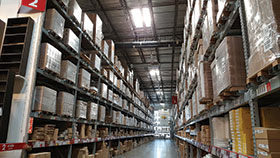

Getting the right product to the right place, on time, might sound easy enough, after all with the pace of change of the digital economy and the development of technologies driving and supporting it one would assume it would be little more than the click of a mouse. However, in the world of large-scale food supply, retail, pharmaceutical and various sectors across the board, product distribution with pinpoint accuracy is far from easy, but it is essential.
From a regulatory perspective, specifically with regards to medical and food supplies, products must be traceable down to the item – i.e. from the point of receiving through to sampling, dispatch and all the way through to delivery to the customer. Assembling orders – known as picking in the industry – can be challenging, as 98% of the distribution is a combination of both case and fine picking making picking orders very inefficient without an automated system in place.
Modern warehouses process hundreds (if not more) of orders daily and with each order there are many individual lines making the consolidation process of picking efficiently very complex. For example, if only one additional minute per item is introduced to a situation where thousands of items are being picked per day – costs escalate significantly. Painstaking attention to detail has, of course, to be balanced with the business need for efficiency and speed.
While the needs of warehouse management systems (WMS) are common across many businesses, the challenge is knowing the intricate issues faced by the different verticals. In food and pharma, it is not only about knowing what’s happening in the warehouse, but also long after the goods have left the warehouse and been delivered. If there are problems with the goods, there has to be full traceability back through the supply chain to the point of origin.
Today’s warehouse management systems can be delivered as a cloud service or on premise with the ultimate goal of improving customer service through speed and accuracy.
As-a-service warehousing
The emergence of the Software as a service (SaaS) model has provided companies with an alternative to the exponential costs involved in having to buy, build, and maintain IT infrastructures. Today organisations can subscribe to services built on shared infrastructure via the Internet.
Technology advancements have been the driving factor in the viability of renting software solutions from companies that make them available through hosted environments. The IT resource requirement is significantly reduced with all system administration tasks being executed and managed centrally.
Service levels are a priority. Providing a solution as a service ensures that vendor support is excellent, and that the customer and vendor have a good and ongoing working relationship. Support costs are lower due to centralised servers being managed and response times are much shorter – it is as though support is actually always on site.
The hosted WMS model has proven in general to have as much as a 70% lower total cost of ownership when compared with traditional on premise systems. The monthly rental method of payment removes software capex requirements and the operational cost is more tax efficient, and provides for greater scalability.
The fundamental aspect of WMS is knowing what stock you have in the warehouse and where it is. This is followed by the critical aspect of ensuring you are able to get the right stock to the right customers at the right time. In today’s digital economy, that is the difference between success and growth versus the way of the dinosaur.
Complex processes
The process starts when stock is first received, knowing how much is coming in and then determining where to ‘put it away’ in the warehouse. There is a whole science to this aspect alone. Imagine if you always put all fast moving items together, which may initially sound logical, but what about the congestion that would be created if pickers were all trying to pick stock from this same location at the same time. This is where you get inefficiencies and loss of productivity, resulting in potential delivery delays.
One example is large retailers, many of whom book a specific delivery time slot for suppliers, but if that is missed, the supplier can end up losing the entire order at worst or at best, being penalised. This often stems from the supplier potentially not knowing where the stock is or congestion created by poorly ‘put away’ stock.
When you combine all the elements from ‘putting stock away’, to picking and preparing it for dispatch, to delivering it to the right customer, the results are massive bottom line benefits.
A WMS must be designed to optimise space utilisation, maximise resource productivity and improve inventory accuracy; order accuracy rate and ultimately customer services. As an example, one of our customers was able to reduce their quarterly variance on R700m worth of inventory to R3500, which is 0.00002%.
Traditionally businesses have focused on revenue and growth in order to compete and gain market share. However, there is increasingly more emphasis on examining the upstream supply chain – not just as a means of reducing costs and therefore improving margin, but rather viewing it as a strategic asset.
If one had a stockpile of cash, one would take many measures to secure that cash, as has been done, with many disruptive technologies arising to offer solutions. Inventory should be no different and the same level of focus is being looked at. This has the double whammy effect in that it creates opportunity for technology, but technology also offers great solutions/options for the supply chain.
For more information, contact Cquential, +27 (0)11 236 4360, info@cquential.com, www.cquential.co.za

© Technews Publishing (Pty) Ltd. | All Rights Reserved.